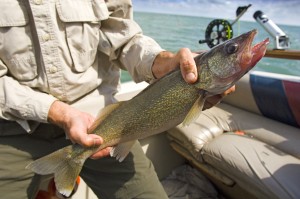
Saginaw Bay as a general rule, for walleye, lake trout, or whatever, the fish are out deep. They’re still getting some walleye over the weed beds along the inner bay in the early morning, but otherwise go deep. Walleye were caught by those trolling crawler harnesses over the weed beds off the Bay City State Park, the Kawkawlin River and over the Callahan Reef in the early morning. As the sun rises, the fish move out to about 25 feet on the east side of the Shipping Channel. This would put them between the Red Spark Plug (Buoys 11&12) and the Green Spark Plug (Buoys 1&2). Fishing in the Slot was slow with only a few fish picked up along the east side. At Caseville, walleye were caught northeast of the Charity Islands, off Oak Point, Oak Beach and off the Hat Reef. Some perch were caught straight out from Quanicassee in 10 feet.
- Saginaw River shore anglers fishing the lower river were catching a few smallmouth bass, rock bass, channel cats and freshwater drum.
- Sanford Lake was still producing good numbers of bluegill and crappie for those fishing the deep edge of the weed beds with small pink or white jigs with twister tails or perch rigs with wax worms over the side of the boat. Good areas were off the Sanford Marina or south of the campground along the flats.
Au Gres Area catch rates were spotty, savvy fishermen were taking good numbers of walleyes using bottom bouncers. A lot of boats were crossing over to fish north of the Charity Islands and around the Steeples but some are also fishing between Point Au Gres and Point Lookout. Either way, success rates were mixed.
- Au Gres River shore anglers were catching a few pike, freshwater drum and a lot really big channel cats.
Outer Saginaw Bay
Oscoda lake trout are scattered throughout in 70 to 170 feet. Anglers reported a good number of walleye south towards Au Sable Point. Late evening was the best time to fish with crawler harnesses, body baits or small spoons. Pier fishing slowed with only a few channel cats and the odd smallmouth caught.
Au Sable River had good smallmouth action further upstream. Not only were the fish bigger but a good number were caught.
Port Austin to Grindstone City was the walleye hot spot with lots of fish including limit catches taken in 20 to 40 feet. Both crawler harnesses and spoons were taking fish. South of Grindstone, the area off the mouth of the New River was also very good. Pier anglers caught a couple smallmouth and the odd walleye at night.
Tawas Area fishing of all sorts was pretty slow in the bay but the one bright spot was several boats picked up walleye out in 60 feet. Those trolling were marking lots of fish but the bite was not there. Pier fishing was slow with only a couple smallmouth, rock bass or small pike taken.
Weekly Fishing Tip: Understanding the Thermocline

Most lakes, sometime during the summer, will develop a thermocline. Understanding how the thermocline works and what it means for your fishing tactics, is important to having a successful day on the water.
Here are a few simple things to keep in mind in relation to the thermocline and its parallel layers.
Epilimnion Layer
This layer is at the top and thus receives the most sunlight. You’ll typically find bluegill and bass (and other warmwater and bait species) here as it’s the warmest.
Thermocline Layer
This is the middle layer. You’ll often find crappie and walleye congregate here.
Hypolimnion Layer
This is the bottom layer and also the coldest and densest. Species you’ll find here include lake trout, whitefish and northern pike.
Keep in mind the thermocline can change day to day and in the fall it will mix with the other layers to create an entirely different dynamic of the lake.
